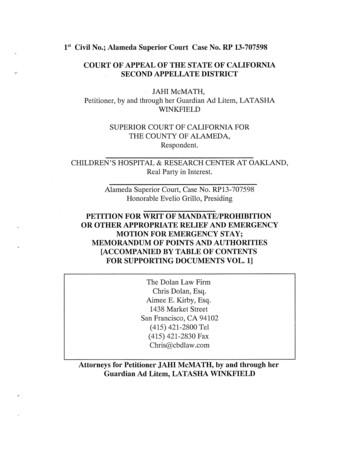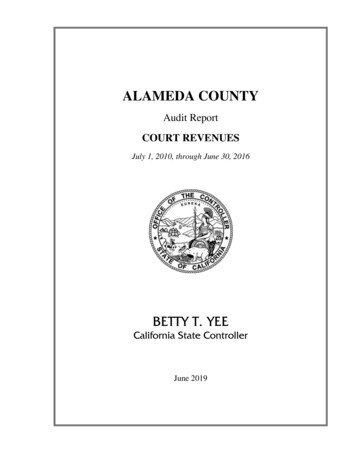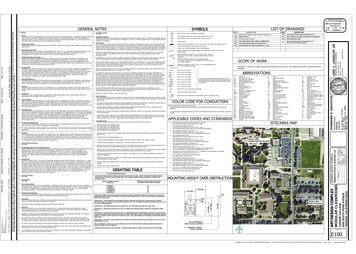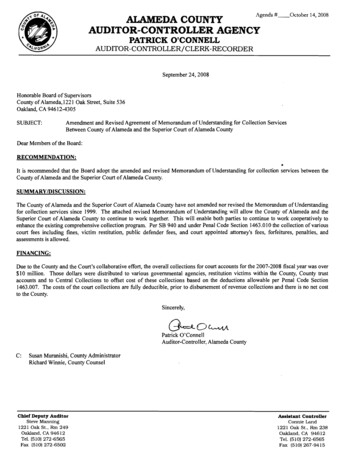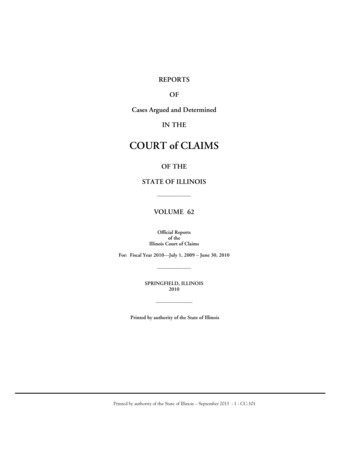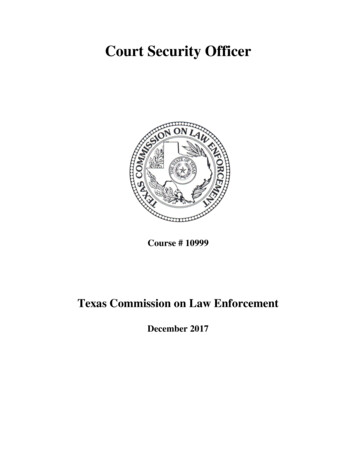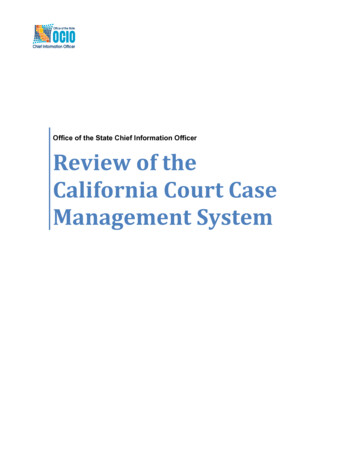
Transcription
Office of the State Chief Information OfficerReview of theCalifornia Court CaseManagement System
CCMS ReviewPage Intentionally Blank to Facilitate Duplex Printing
CCMS ReviewExecutive Summary . 5Background . 8Current Status of the CCMS Project. 11Scope of the Review . 12Methodology for the Review . 13Review Framework . 14Project Concept . 15Project Initiation . 16Project Planning . 18Project Execution . 20Project Closure . 23Conclusions . 24Attachment A - Complexity Assessment. 24Attachment B – Gartner Business StudyAttachment C – Independent Verification, Validation and Oversight Report
CCMS ReviewPage Intentionally Blank to Facilitate Duplex Printing
CCMS ReviewExecutive SummaryCalifornia’s court system is the largest in the nation. The sheer magnitude of its size as well asthe functional complexity of its operations makes the California Court Case ManagementSystem (CCMS) one of largest Information Technology (IT) projects the state has ever initiated.Pursuant to a request by the Legislature and questions raised by members of the Legislature ata legislative hearing on October 28, 2009, the Office of the State Chief Information Officer(OCIO) conducted a review of the Court Case Management System (CCMS). Through thisreview, the OCIO considered the objectives, activities and costs of the CCMS in the context ofdefining overall project success. Based upon our review and analysis, the OCIO makes thefollowing observations and recommendations:GovernanceThe governance plan for CCMS should be augmented to ensure the commitment ofthe county superior courts to adopt and use the system. The governance plan shouldalso assess the business value of partial deployment of the system if total deploymentis not feasible.The benefits of the CCMS to the court system as a whole (“the enterprise”) shouldtake priority over the unique needs of individual courts. The decision-making processfor standardizing common practices and tools must be collaborative and inclusive, yetstart from a position of achieving maximum benefits to the greatest number of courts.As county superior courts are the end users and customers of the CCMS, it is criticalthat their true needs and concerns are considered and addressed in a timely fashionwhile not compromising the enterprise needs of the Judicial Branch.Deployment StrategyThe Administrative Office of the Courts (AOC) and the CCMS project team shouldfully define, baseline, and document the extent to which the system will be deployed,and the timeline and resource requirements for the entire deployment phase. Thisplan should identify required staff resources as well as the cost of system interfacesand data conversion.The AOC should not accept or deploy the V4 system beyond the first county superiorcourt in the pilot phase of the system deployment until it is fully operational andutilizing live data.5
CCMS ReviewThe CCMS project team should ensure that all system testing activities andprocedures are adhered to and completed in the live environment prior to the start ofthe vendor warranty period.Project ManagementThe AOC should enhance the project and contract management resources dedicatedto the CCMS project to ensure the state’s interests are being met by the vendorresponsible for developing and implementing the system.The AOC and the CCMS project team should develop a detailed plan for how, and bywhom, the system will be supported during the maintenance and operation period.The AOC should adopt a common methodology and tool set for project managementacross the Judicial Branch.Cost ManagementThrough existing governance mechanisms, the Judicial Branch should determine acost cap for the project based on the value of the system to the enterprise as well asthe value of the system to individual courts.Within the common project management methodology recommended above, the costmanagement plan and tools should define when projects start and stop, which projectcosts will be captured to what extent, and easily allows transparency to the projectscomplete one-time costs (build), and annual operational costs (maintain).Technology Management and ReviewThe ability to share and leverage data across the court system and with justicepartners will produce significant benefits to the state. To this end, the systemapplication should be deployed to the maximum number of courts and all courtsshould utilize a common database. Achieving this end state requires that the AOCand CCMS project management work with internal and external partners on systemadoption and use of the 121 standard interfaces developed within the V4 projectscope.The number of permutations of the CCMS application and database should be limitedto achieve the maximum benefits from the system. To the extent possible, the CCMSV4 should be hosted at a centralized site for all courts unless it is demonstrated thatthis model cannot meet the product service level agreements.6
CCMS ReviewThe AOC should develop a well governed process for coordinating changes andversion control for application maintenance in both the product application stack andthe developed CCMS application solution.Despite the challenges to date, the OCIO believes the CCMS project can be successfullyimplemented if the recommendations discussed above are implemented.7
CCMS ReviewBackgroundCalifornia’s court system is the largest in the nation with over 500 court locations, 19,000employees, and serving over 37 million people with over 9 million cases.1 The sheer magnitudeof its size as well as the functional complexity of its operations makes the California Court CaseManagement System (CCMS) one of largest Information Technology (IT) projects the state hasever initiated. The complexity of the project is heightened by a number of factors, including:The number of physical locations where the system will be used;The number of system users that must be served and trained;The number of system stakeholders who must be engaged, managed, and governed;The culture shift of recent centralization efforts including transition of 220 local courtsoperating independently to 58 superior courts statewide.The level of process change inherent in the system; andThe relative newness of technology to court operations.The size and magnitude of the CCMS project is comparable to some of the largest IT projects inthe Executive Branch, such as:Project NameTotal ProjectCostFinancial Information System for California(FI Cal)CCSAS-Child Support Enforcement (CSE)Court Case Management System (CCMS)CriticalityLevel 1,620,052,5183-High 1,552,411,070 1,335,815,7693-High3-HighSee Attachment A for the full complexity assessment.While there is not uniform agreement as to the scope of CCMS, and what historical casemanagement technology efforts the project includes, for the purposes of this report the Office ofthe State Chief Information Officer (OCIO) has defined the project as beginning in 2002following direction from Governor Davis to create the system and the receipt of 21 million infunding to start the project. This scope includes three system products known as V2, V3, andV4.In an effort to consolidate case management systems within the courts and increase the abilityto share data statewide among the Administrative Office of the Courts (AOC), local superiorcourts, and state and local justice partners (e.g., the Department of Justice, the Department ofSocial Services, and local law enforcement agencies) the CCMS project was initiated in nts/factsheets/Calif Judicial Branch.pdf8
CCMS Review2002. The CCMS is a custom software development project that was developed in iterativephases, with the intent being that lessons learned from each phase would assist in the planningof the next phase.CCMS V2 - The first phase product was scoped to include case management activities for trafficand criminal functions within the courts. The development of the V2 product was challengedand was ultimately only implemented in Fresno County in July of 2006.CCMS V3 - The second phase product was scoped to include case management activities forcivil, probate, small claims, and mental health functions within the courts. The V3 product iscurrently deployed in six counties, including: Los Angeles; Orange; Sacramento; San Diego;San Joaquin; and Ventura. These installations represent approximately 25 percent of thestate’s court caseload. Three of the installations (Los Angeles, Orange, and San Diego) hosttheir own instances of both the application and the database. The rest of the counties use ashared system hosted at the California Courts Technology Center (CCTC), the AOC’s datacenter.CCMS V4 - The third phase product was scoped to include:All of the functionality of V2 and V3;Family law and juvenile justice case management;A public/partner portal;A set of standard justice partner data exchanges;Integration with document management systems;Court interpreter scheduling;Court reporter scheduling, and;E-FilingThe V4 product is currently in the integration testing phase. The AOC contracted with DeloitteConsulting for the development of V3 and V4 and most V3 deployment activities.9
CCMS Review2Remaining51 CountiesVenturaSanJoaquinSacramentoSan DiegoOrangeLos JuvenileV41JusticeFresnoCCMS Implementations to Date -- -- --- -- -- -- --V4 includes all V2 and V3 functionality10
CCMS ReviewCurrent Status of the CCMS ProjectThe project is formally scheduled for only the development of the V4 product. The project is inthe execution phase of project management lifecycle and the integration testing phase of theSystem Development Life Cycle. The January 2010 project schedule and reporting depicted theproject to be on schedule to meet the completion date of September 2010. However, the projectteam reported in late February that it expects to deviate from the September completion datedue to issues discovered during the integration testing. The deviation is expected to beapproximately six months to complete the V4 product build, delaying the product completion toApril 2011. This includes the product build, testing, and product acceptance, but notdeployment of V4. High level deployment planning for V4 currently calls for a three county pilotincluding San Diego, Ventura, and San Luis Obispo counties.Actual expenditures are reported by fiscal year with the most recent data available through2008-9. Expenditures through 2008-9 are reported at 386 million which includes one-timedevelopment and ongoing operation costs of deployed versions (V2 and V3) as well asdevelopment costs for V4. Total costs are currently estimated to be 1.3 billion for one-timedevelopment inclusive of V2, V3, and V4, and 79 million for annual maintenance andoperation.11
CCMS ReviewScope of the ReviewThis review was conducted pursuant to a request by the Legislature and questions raised at alegislative hearing on October 28, 2009. This review focuses primarily on the Court CaseManagement System (CCMS) V4 software product currently in development. The OCIOconsidered initial objectives and activities and costs to date in the context of defining overallproject success. The OCIO did not attempt to review, analyze, or validate all of the projectactivities since its inception in detail. A review of the installed V3 product was conducted todetermine the probability of future success of the V4 product. The scope of the OCIO’s reviewincluded the following broad questions:1.2.3.4.5.6.What is the business value to having the system?Will the system work?Will the project be successful?Is oversight being performed on the project?Is the project costing more than it should?When will the project be done?This review was also conducted consistent with SBX4 13, Chapter 22, Statutes of 2009 whichstipulates that the OCIO review and make recommendations for any Administrative Office of theCourts (AOC) project over 5 million.While there are many contributors to project success, including the definition of success itself,the OCIO selected the high level focus areas below as being particularly relevant to theconcerns about CCMS and to the current phase of the project. These areas also provide thebest insight into the likelihood of success in a way that is commensurate with the scope anddepth of this review.Governance: The extent to which the project has the appropriate stake holder buy-inand/or authority to implement the technology and ensure its use.Software Development Management: The extent to which software developmentactivities are adhering to industry best practices.Project Management: The extent to which the project is being managed according toindustry best practices.Cost Management: The extent to which costs are being controlled and managed.Technology Review: The extent to which the system is appropriately designed and sizedto meet the programmatic needs of the courts.Deployment Strategy: The extent to which deployment and implementation activities areappropriately planned to facilitate success and lessen risk.12
CCMS ReviewMethodology for the ReviewThis review followed the same processes the OCIO uses to conduct project oversight andescalate project issues within the Executive Branch. These processes align to the ExecutiveBranch’s Oversight Framework, the California Project Management Methodology (CA-PMM)and adhere to industry standards and best practices.For each of the focus areas analyzed in this review, the following activities were performed.1. Do the project artifacts/plans exist? This is performed by a review of the projectdocumentation.2. Is there evidence/validation that the plans are adequate and used operationally andeffectively? This is performed by document review and interviews with project staff.3. What are the significant risks/issues the project is experiencing and what are therecommendations to address them? This is performed by document review, staff andexternal stakeholder interviews, and demonstrations of the system.The OCIO performed document review within the vendor’s project library, the AOC’s projectlibrary, and reviewed documents and reports from individual courts, the AOC, the Legislature,and the Legislative Analysts’ Office. Interviews were conducted with judges, technologyexecutives, managers, and clerical staff from within the courts and the AOC, and with thedevelopment vendor, and the oversight vendor.13
CCMS ReviewReview FrameworkThe OCIO aligned the detailed findings and recommendations of the CCMS with the CaliforniaProject Management Methodology utilized by the state’s Executive Branch agencies in thedevelopment of IT systems. While the Executive Branch has very specific activities andapprovals required throughout the IT Project Management lifecycle, the CA-PMM is aligned withbest practices for project management. The five stages of the IT project life cycle and sectionsof this review are as follows:1.2.3.4.5.Concept;Project Initiation;Planning;Execution; andClosing.California Project Management Methodology – IT Project Lifecycle14
CCMS ReviewProject ConceptThe purpose of the Concept Stage in project management is to communicate high-levelinformation about an idea for an IT project. At this stage, IT projects are assessed at a highlevel for their potential value, their alignment with organizational strategy, and whether theyoverlap with other existing or proposed projects. The major output of this stage is a ConceptStatement. Usually written by the customer, this statement captures the intent of the projectgiving the Project Manager, customer, and all stakeholders a starting point for initiating aproject.The Executive Branch utilizes a 5 year IT capital planning process in which all envisioned ITprojects within agencies and departments are assessed and submitted for approval annually.Agencies are first responsible for prioritization of need, capacity to perform, alignment with statedirection, identifying overlap with existing efforts or opportunities for collaboration, and approvalof departmental concepts within the Agency portfolio. The OCIO then performs the process forthe entire Executive Branch’s portfolio. The concepts are approved, denied, or conditionallyapproved such as being directed to leverage existing resources and/or knowledge and/orworking collaboratively with other departments seeking to solve the same problem. TheExecutive Branch is able to see overlap and opportunities for collaboration because of thebreadth of the portfolio.The AOC has a project concept initiation process similar to the process discussed above.RecommendationsConsistent with SBX4 13 (Statutes of 2009), the AOC should submit IT projectconcepts with an estimated cost of 5 million or more to the OCIO using the OCIO’sexisting process. While these concepts will not require approval from the OCIO, theOCIO will review and analyze these concepts. This process will allow the JudicialBranch to leverage IT efforts already underway in Executive Branch agencies as wellas benefit from a broader pool of experience and expertise.15
CCMS ReviewProject InitiationThe purpose of the Initiating Stage is to “authorize and define the scope of a new project”(PMBOK ). It defines the project’s business case including the purpose and project businessobjectives and further refines estimates of the scope, schedule, and costs. The result sets thebenchmark for investment vs. value at the point in time. In the Executive Branch, the vehicle forstudying, reporting findings, and requesting approval to proceed is the Feasibility Study Report.At initiation, the AOC did not perform a formal business case for the project which would includean assessment of the existing (baseline) business, related costs, and how that would compareto the new business with the CCMS in place. A CCMS business case was formallydocumented, but it was not completed until well after the project was initiated (December 2007)and did not fully assess the complete baseline costs of the business. The business casedeveloped by Gartner (see Attachment B) estimated potential ROI savings of moving topaperless environments in all counties at 157 million annually, which in part includes:Electronic Filing - 78 million per yearElectronic Calendars - 23 million per yearSelf Service Case Inquiries - 11 million per yearSelf Service Payments - 22 million per yearAccording to the AOC, the annual cost to maintain the V4 system is estimated to be 79 millionper year. If all estimated savings and cost avoidances were realized, this would result in a 78million net positive (exclusive of build costs) return on investment per year based just onongoing maintenance. Without more complete information, the OCIO is unable to take aposition on the absolute value of the project. However, the anticipated value of the CCMSshould be derived from the following areas:The value of having a court case management system to replace failing systems inindividual courts.The value of having a ready automated system for courts that currently use completelymanual processes.The value of automating some manual processes within a court thereby reducing time toinput data, time to retrieve data, and paper storage costs.The value of allowing e-filing (self-service) to the public.The value of sharing data across courts.The value of sharing data between justice partners (DOJ, CHP, Local LEAs, DSS, DCSS,CDCR)Cost avoidance due to the consolidation of over 70 different instances of differentsystems.From a systematic perspective, because some of the baseline costs for the items above werenot studied in detail, the intangible nature of some project benefits, and because the AOC does16
CCMS Reviewnot have a standardized cost and expenditure model; a set monetary value (expense cap) forthe system is impossible to determine.The AOC also estimated the one-time cost of replacing existing systems in a piecemeal fashionat between 622 million to 1billion. While the OCIO is unable to validate these cost avoidanceprojections, our experience leads us to believe that the development and deployment of a singlecase management solution will be less costly than the development and deployment of multiplesolutions from a total cost of ownership perspective.The table below illustrates CCMS project benefits in the seven major areas in terms of one-timeand operational expense and intangible service improvements, based on available information.ItemValue of ReplacingExisting SystemsValue of having a readyautomated system forcompletely manualcourts.Automating ManualProcesses within courtsValue of self-service (efiling) to the public andpartnersValue of sharing dataacross courtsValue of sharing dataacross justice partners.Estimated/Perceived Value 622 - 1,008 millionone-time cost avoidanceMonetary value Included inabove. Also gives anopportunity to small courts thatmay not be able to affordautomated systems 157 millionannual cost savingsInformally defined butconsidered high value forconstituents using the courtsystem.SourceAOC StudyOCIO AnalysisGartner CCMSBusiness CaseOCIO AnalysisInformally definedN/AInformally definedN/AInformally defined but generallyConsolidating Statewideconsidered good businessInfrastructure/Processespractice17OCIO Analysis
CCMS ReviewProject PlanningThe purpose of the Planning Stage is to “define and mature the project scope, develop theproject management plan, and identify and schedule the project activities that occur within theproject” (PMBOK ). The various plans from this process group may be simple for a low-riskproject, or more elaborate for a high-risk project. Stakeholders should be involved in theplanning process, leveraging their skills and knowledge, and setting the stage for opencommunication.The AOC has been challenged in managing the scope, schedule and cost of the CCMS projectpartially due to incomplete information about business requirements and processes during theinitiation stage, the complexity of the project, and external factors impacting the project. Whilethe existing schedule, scope and cost is sufficient for the development phase of the project, theplan for CCMS V4 does not include information about the schedule or resource requirements forsystem implementation in sufficient detail. The current plan is high level and assumes astaggered three court early adopter period to be followed by waves of other courts.In addition, the definition of the business value achieved to date from CCMS is unclear. Whilesome value has been realized through the V2 and V3 installations in terms of replacing existingsystems, and reducing data entry and paper storage and retrieval costs, the Judicial Branch hasyet to realize the value of sharing data across courts or with justice partners, nor have therebeen any reductions in IT infrastructure and operational costs due to system consolidation.In general, the project appears to be using industry best practices for software development andproject management for the scope of building the CCMS V4 product. The expected plans anddocuments reside in the vendor library and appear to be updated regularly. However, thediligence in formal project management appears to be driven by the systems integration vendorrather than the state CCMS project team. Additionally, the AOC does not have formal projectmanagement practices and tools in place, such as standard methods or tools for estimating,tracking, and reporting on project costs. This makes determining the precise level ofexpenditure difficult and reported numbers subject to interpretation.RecommendationsThe Administrative Office of the Courts (AOC) and the CCMS project team shouldfully define, baseline, and document the extent to which the system will be deployed,and the timeline and resource requirements for the entire deployment phase. Thisplan should identify required staff resources as well as the cost of system interfacesand data conversion.The AOC should enhance the project and contract management resources dedicatedto the CCMS project to ensure the state’s interests are being met by the vendorresponsible for developing and implementing the system.18
CCMS ReviewThe AOC should adopt a common methodology and tool set for project managementacross the Judicial Branch. Within the common project management methodology,the AOC should ensure that the cost management plan and tools define whenprojects start and stop, which project costs will be captured to what extent, and easilyallows transparency to the projects complete one-time costs (build), and annualoperational costs (maintain).19
CCMS ReviewProject ExecutionThe purpose of the Executing Stage is to “complete the work defined in the project managementplan to accomplish the project’s objectives defined in the project scope statement” (PMBOK ).The project has strong sponsorship and backing at the highest level of the Judicial Branch. TheCCMS’ project sponsor, Chief Justice Ronald M. George, is fully supportive of the project. Whilethe Judicial Council has legal authority over strategic direction, policy, and funding for the state’scourts, it is the OCIO’s experience that, regardless of authority, buy-in for IT projects acrossmulti-jurisdictional boundaries is extremely difficult and requires well defined processes, policiesand procedures. While some courts have volunteered to be part of the CCMS project, there isnot a comprehensive plan that ensures county superior courts will implement and use thesystem. If identified courts do not agree to implement the system and/or if court employees donot effectively utilize the system, the value of the system as a tool for data sharing andmanagement will be limited.Since 2007, the AOC has utilized a contractor to perform Independent Verification andValidation (IV&V) and Oversight functions on the project. However, the scope of the oversightactivities performed the IV&V vendor is limited to the development of the CCMS V4 product. Themonthly IV&V report uses a checklist similar to that used by the Executive Branch for IV&Vactivities (the February 2010 IV&V and Oversight report is included as Attachment C).The V4 product application stack (software suite) is an architecturally sound product solutiongiven the size and complexity of CCMS. However, due to the number of products andcomplexity of integrating these products, the OCIO identified the need for a well governedprocess for coordinating changes and version control for application maintenance in both theproduct application stack and the CCMS application solution.The current V3 environment has four primary points of distribution for system (application anddatabase) implementation. Allowing some courts to host their own application and databaseincreases system complexity and negatively impacts system performance. The distributednature of the V3 architecture is also more costly to operate and maintain than a morecentralized approach. In addition, best practices for system implementation dictate that systemdistribution, both at the application and database layer, be centralized in order to ensure theefficient management and system performance.The OCIO has concerns over the ability and time required to address problems that are beingdiscovered in the integration testing phase. Testing has revealed significant defects and otherissues, including problems with the system testing process. The CCMS project team nowexpects delays to correct these issues. The risk list and the IV&V report a goal to clean up thetesting scripts and the AOC asserts that they will not move into Product Acceptance Testing(PAT) until the integration issues are resolved. While there is a defined software developmentlifecycle (SDLC) for the CCMS project in place for requirements elicitation, product testing, and20
CCMS Reviewproduct acceptance, there are indications that lead us to conclude that proper due diligence maynot have always bee
8 CCMS Review Background California's court system is the largest in the nation with over 500 court locations, 19,000 employees, and serving over 37 million people with over 9 million cases.1 The sheer magnitude of its size as well as the functional complexity of its operations makes the California Court Case





